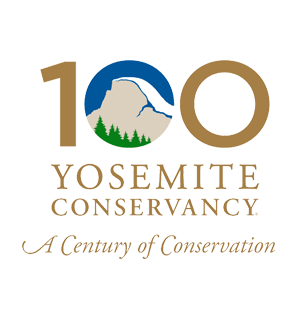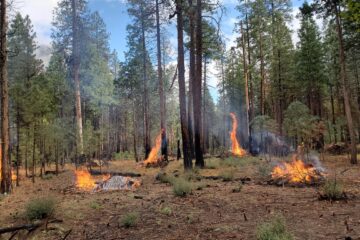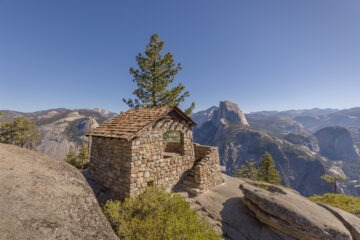California is home to 21 national monuments, including Yosemite National Park’s closest neighbor, Devils Postpile National Monument. This park is known for, and named after, one of the world’s finest examples of columnar basalt, the Devils Postpile (pictured above and below). Although not as well-known as Half Dome or El Capitan, the Devils Postpile rock formation is indeed a geologic wonder of its own. In fact, due to the formation’s grandeur, the Devils Postpile was once included within Yosemite’s park boundary.
If you’re like us, you’re probably on the verge of googling everything there is to know about how nature can create something like Devils Postpile (and maybe why humans would separate it from Yosemite). Keep reading to learn how this structure likely formed, as well as some important details about how to visit the park and the history of the area:
- Yosemite and Devils Postpile’s intertwined history
- The magic of columnar basalt
- Other sights to see and things to do
- Park hours and seasonal closures
- Transportation (aka the mandatory park shuttle)
- Upcoming Devils Postpile film
- Learn more about local geology!
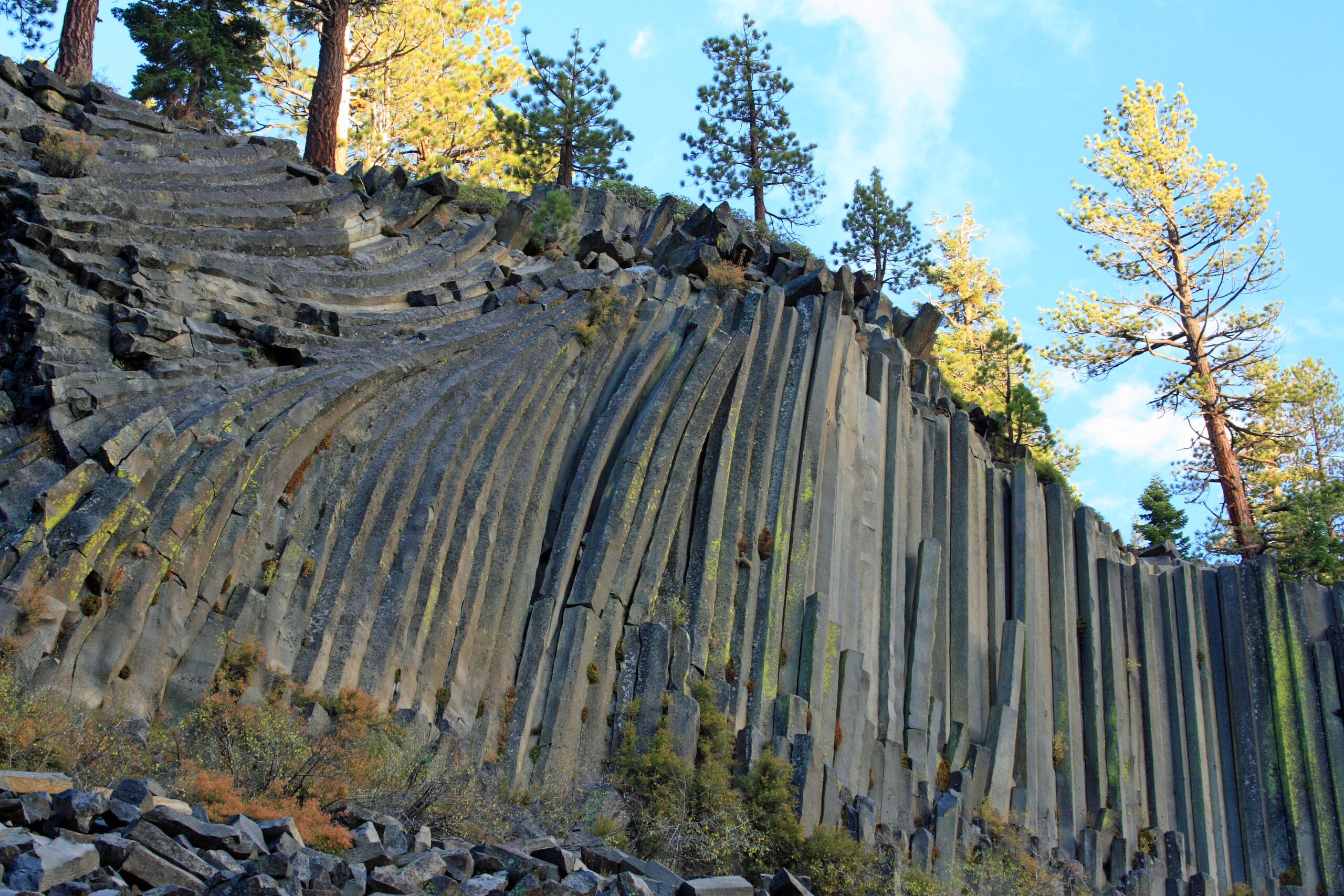
The columns of the Devils Postpile formation. Photo courtesy of Frank Kovalchek.
An Intertwined History
When Yosemite National Park was first established in 1890, the park boundary included all 800 acres of what is now known as Devils Postpile National Monument.
This direct connection between the parks was unfortunately short-lived. When gold was discovered in the Mammoth Lakes area in the early 1900s, the entire Middle Fork Valley — which includes Devils Postpile — was removed from Yosemite’s park boundary and designated as part of the Sierra National Forest. The US Forest Service subsequently opened the area to commercial development (a.k.a. mining!).
The devil really is in the details though, and the rugged, detailed landscape of Devils Postpile resulted in little gold actually being found in the area. So, shortly after in 1911, the area was officially designated as a National Monument, bringing an end to all mining in the area, and a new era of preservation and stewardship. Nonetheless, a decade of mining operations — blasting, woodcutting, water diversions, etc. — has had lasting environmental effects on the region.
These days, Devils Postpile National Monument is open seasonally in the summer (usually June to October, see below for details), and is a great stop on your way to/from Yosemite, or a great trip on its own. Visitors of this small park unit have the chance to explore the columnar basalt structure, hike and backpack the park’s eight miles of trails, go fishing and horseback riding, and so much more!
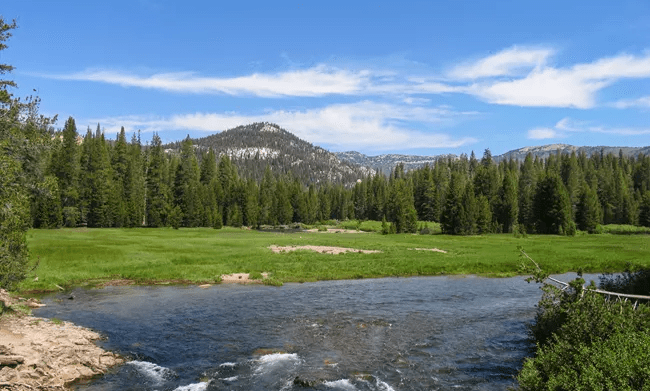
Soda Springs Meadow and the San Joaquin River. Photo courtesy of the National Park Service.
The Magic of Columnar Basalt
The Devils Postpile is a formation of mostly hexagonal rock columns that reach up to 60 feet into the air in a manner that looks like tall posts stacked in a pile, hence the name.
Rock formations like Devils Postpile — structures formally known as columnar basalt — are found around the globe, and though they may look man-made, were all created by nature.
But how could something so symmetrical and perfectly sculpted be carved by nature? Well, it begins with a lot of lava and a lot of time.
The story of the Devils Postpile begins approximately 80,000 to 100,000 years ago with a volcanic eruption near the Middle Fork of the San Joaquin River. The resulting molten basaltic lava (lava rich in iron and magnesium) flowed into a nearby valley and pooled to an incredible depth of approximately 400 feet. And, because this pool of lava was so dense and deep, it cooled very slowly — like a large pot of soup that stays hot long after you’ve turned off the stove.
The lava’s outer surfaces, which were exposed to the cool air and ground, lost heat first and began to solidify into rock, while the lava inside remained molten.
As this outer rock surface cooled, it contracted, and cracks began to form. In basalt, this contraction tends to create a network of polygon-shaped cracks, most often with six sides. As the pool continued to cool, these cracks worked their way down through the mass of cooling lava, ultimately creating long, vertical columns.
Then, around 65,000 years ago, glaciers carved their way through the valley, scrapping away debris and exposing the tops and sides of the columns we see today. With this new view, we can see that many of the columns are nearly perfect hexagons. In fact, Devils Postpile is ranked as one of the world’s finest examples of columnar basalt because it contains a higher-than-average percentage of hexagonal columns (55%) compared to other columnar basalt formations.
The Devils Postpile is an amazing feat of nature, and knowing how it was formed makes it even more cool (pun intended)!
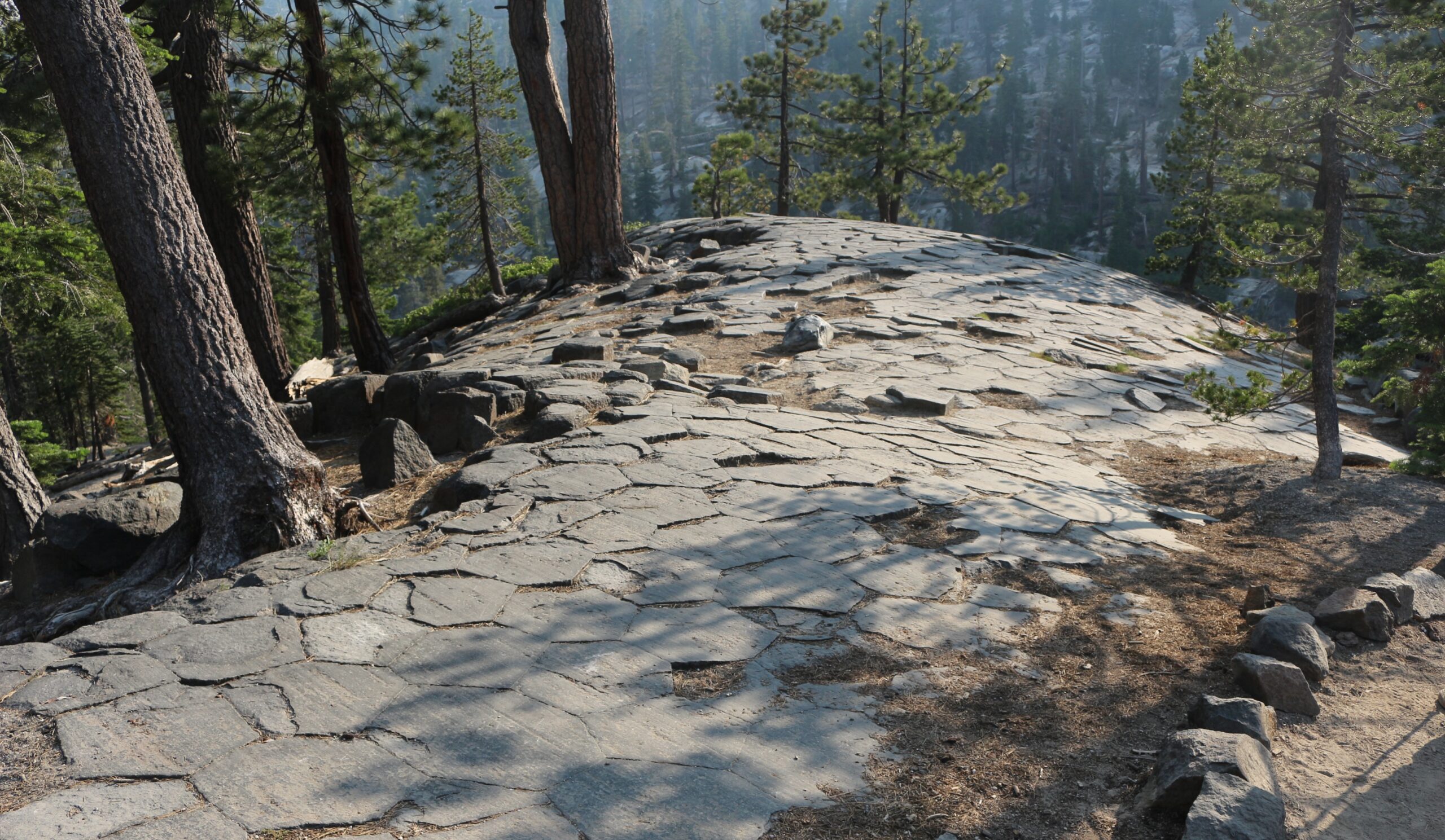
Glacial polish on the top of the Devils Postpile formation. Photo courtesy of Lucas G.
Other Sights to See and Things to Do
Rainbow Falls: This magnificent 101-foot-tall waterfall is aptly named for the frequent rainbows that appear in its mist on sunny summer days. Visitors interested in visiting the falls can access the Falls from Devils Postpile Ranger Station (5 miles roundtrip, moderate).
Hiking: The monument’s eight miles of trails offer stunning views of the High Sierra and Ansel Adams Wilderness, with options for beginners and expert hikers. Some of our favorites include the easy 0.8-mile hike to the base of the Devils Postpile rock formation, and the five-mile trail to Rainbow Falls.
Ranger Guided Programs: Ranger-guided programs are a great way to learn about Devils Postpile and the surrounding area. A variety of programs are listed on the park’s events calendar. Call 760-934-2289 for more information.
Camping & Lodging: The Devils Postpile 20-site campground has been closed since 2016 to address infrastructure repairs and safety needs, but nearby there are five seasonal Forest Service campgrounds that are located just outside the monument’s boundary: Upper Soda Springs, Pumice Flat, Pumice Flat Group, Minaret Falls, and Reds Meadow campgrounds. There are also a variety of hotel and temporary rental options in the nearby Mammoth Lakes area.
Backpacking: Wilderness permits are required for all overnight trips and can be obtained from the Inyo National Forest. Please remember that you are also required to carry/use an approved bear-resistant food storage container while backpacking. Learn more about the requirements, bear safety, and how to book here.
Travel with your Pup: Your four-legged friends are welcome at Devils Postpile in the campground, day-use areas, and on trails. The National Park Service just asks that you follow a couple rules to keep both you, your pup, and the park’s wildlife safe.
Learn more about outdoor activities at the monument, including horseback riding, fishing, and wildlife watching on the National Park Service’s website.
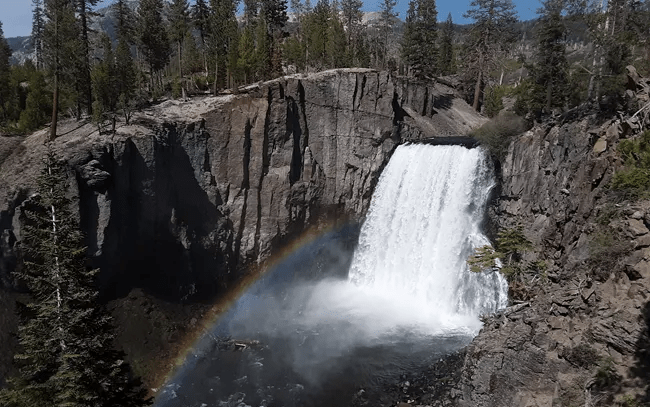
Rainbow Falls — the highest waterfall on the Middle Fork of the San Joaquin river. Photo courtesy of the National Park Service.
Park Hours and Seasonal Closures
In planning a visit to Devils Postpile National Monument, it’s important to remember that this park is only open seasonally during the summer months.
The national monument and adjacent Reds Meadow Valley area are both accessible by one road — Reds Meadow Road. In the winter months, the road’s high elevation and resulting heavy snowpack present extreme hazards for vehicles traveling along this route. As a result, the park’s operating season is heavily dependent on winter storms and snowpack.
The monument is usually open from mid-June to mid- to late-October, with opening and closing dates shifting slightly due to higher or lower than average levels of snow.
**Important note about 2025: Reconstruction of Reds Meadow Road is underway to improve public access and reduce the likelihood of vehicular accidents in the area. Project completion is scheduled for 2026, but the road will be partially open throughout the 2025 summer season. As Reds Meadow Road is the only way in/out of Devils Postpile, please visit the Inyo National Forest’s website when planning your trip to ensure that you are entering/exiting when the road is open.**
In past years, the Devils Postpile and Reds Meadow have been open 24 hours a day, 7 days a week during the summer season. During these years, the Devils Postpile ranger station has also been open daily from 9am to 5pm. According to the National Park Service’s website, the ranger station will be open in 2025 from 9am – 5pm, Friday through Sunday, and is easiest to access via the ESTA shuttle bus. Please visit the National Park Service’s website for the most up to date information on park hours.
In the winter months, the park is still accessible to backcountry skiers and snowshoers, but the 9-mile trek to the monument (18 miles round-trip) is extremely strenuous, and there are no facilities available in the monument. Winter visitors should be skilled in the backcountry, overly prepared, and self-sufficient.
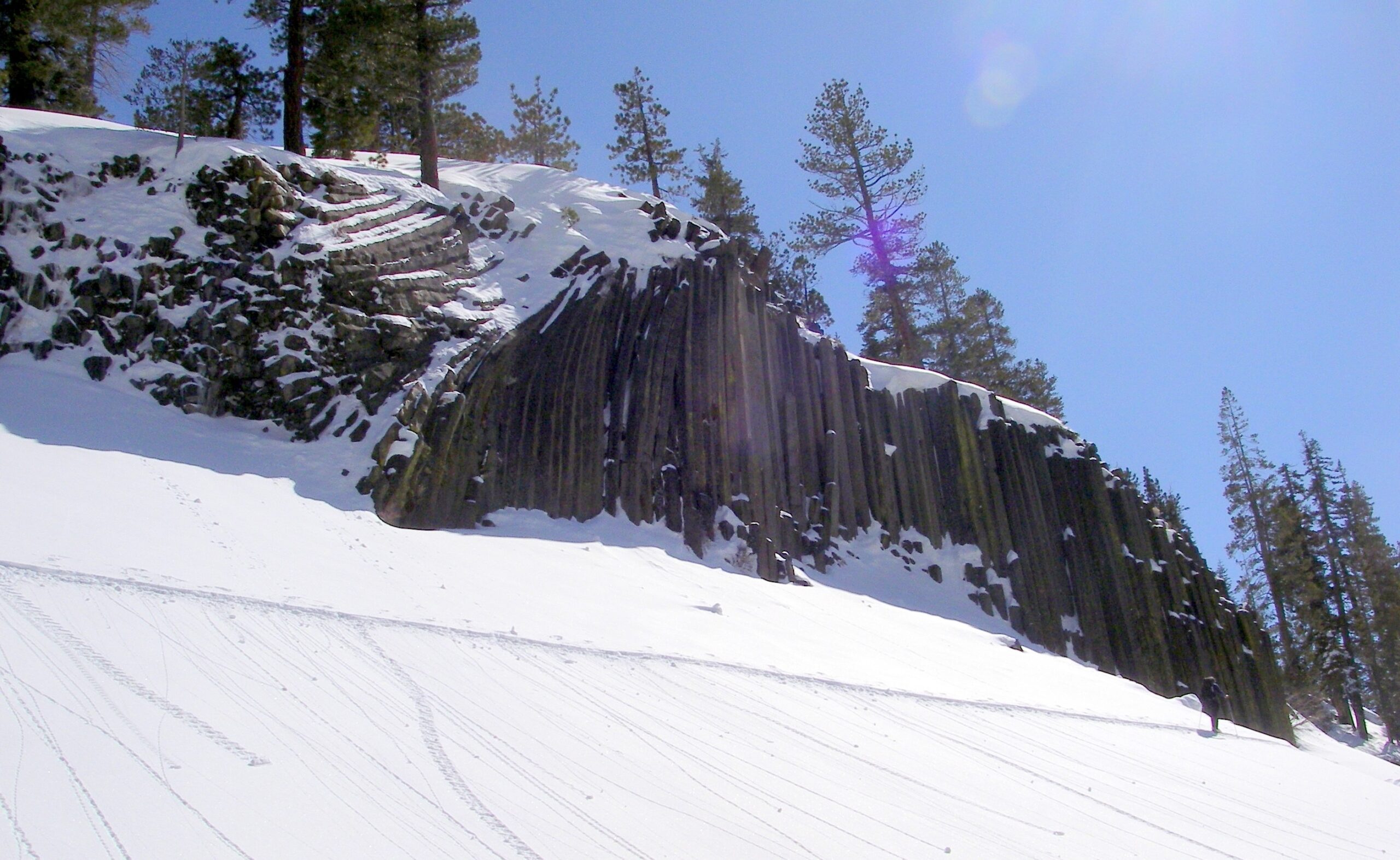
Although the facilities are closed in the winter, skiers and snowshoers enjoy peace and quiet within the monument. Photo courtesy of the National Park Service.
Transportation (aka the mandatory park shuttle)
For most of the open summer season, visitors are required to take a free, shuttle into Devils Postpile National Monument and the Reds Meadow Valley area.
The shuttle runs daily during the open summer season, running every 20-45 minutes between 7am – 7pm. The shuttle bus travels from the Mammoth Mountain Lodge area to ten bus stops in the Reds Meadow Valley, including the Devils Postpile and Rainbow Falls trailheads.
Tickets can be purchased online or at the Mammoth Mountain Adventure Center near the Mammoth Mountain Lodge. Click here for more information about the shuttle bus.
After Labor Day, the shuttle bus stops running, but Devils Postpile stays open into the fall until the first heavy snow. When the shuttle bus is not running, you may drive your vehicle (of up to 25ft) into the monument, but please keep in mind that the road is narrow, steep, and poses certain hazards to drivers.
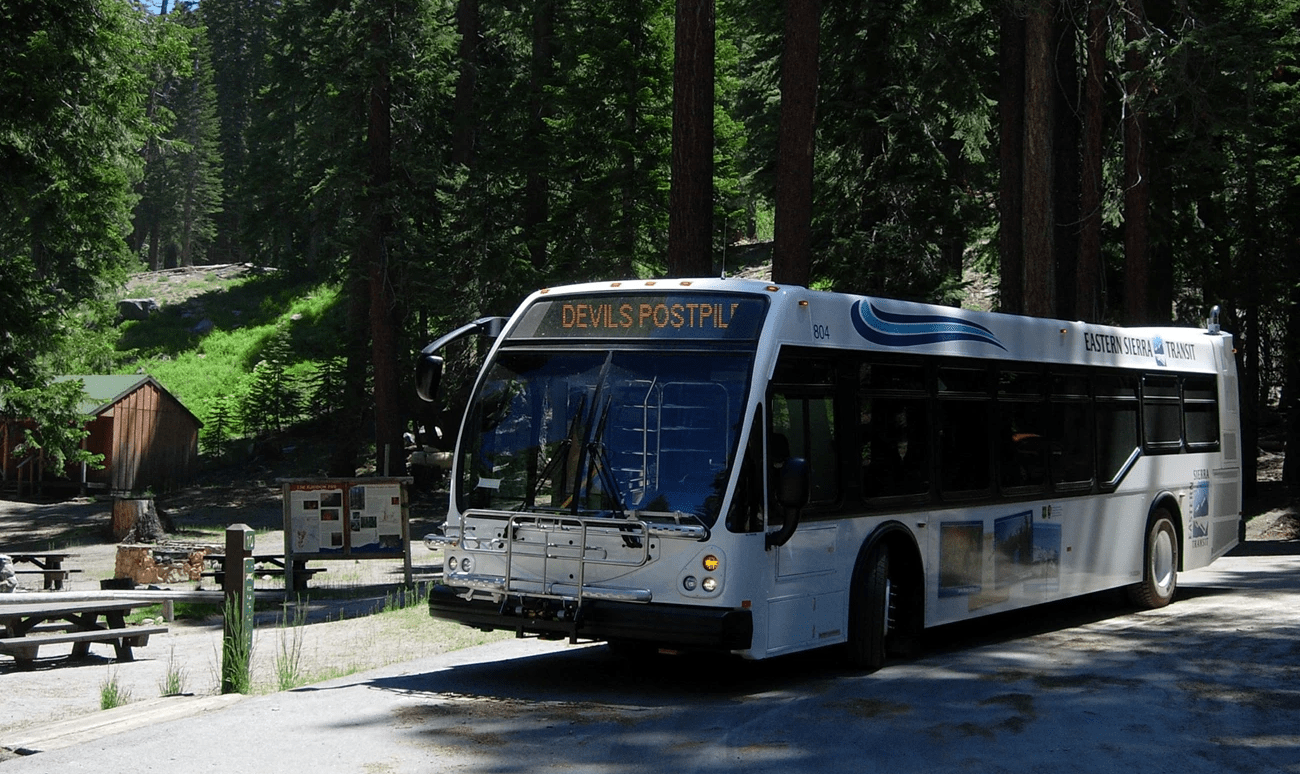
Reds Meadow Shuttle Bus. Photo courtesy of the National Park Service.
Upcoming Devils Postpile Film
Devils Postpile shares a deep history with Yosemite National Park, but lacks the same visibility and interpretation. In 2025, to address the lack of knowledge and visitation at Devils Postpile, Yosemite Conservancy donors are funding the creation of a film that shares the story and geologic significance of this amazing national monument.
The film will help potential visitors understand the uniqueness of the volcanic and glacial processes that created the Postpile formation, the importance of the San Joaquin River for the livelihood of California’s population, the traditional uses of this high-altitude corridor for Indigenous people, and an appreciation of the wildlife that rely on this habitat.
Look out for updates about the film on our website and social media platforms.

The columns of the Devils Postpile formation. Photo courtesy of the National Park Service
Learn more about geology in the greater Yosemite area!
Inspired to learn more about the remarkable rock formations in Yosemite and beyond? Check out Yosemite Conservancy’s guided Outdoor Adventure programs! Alongside an expert naturalist guide, you’ll explore the ancient forces that created icons like Half Dome, Glacier Point, El Capitan, and much more! Click here to view the full calendar of Outdoor Adventure programs.
